Film Credits
Courtesy of Scott Galloway, No Mercy/No Malice, @profgalloway
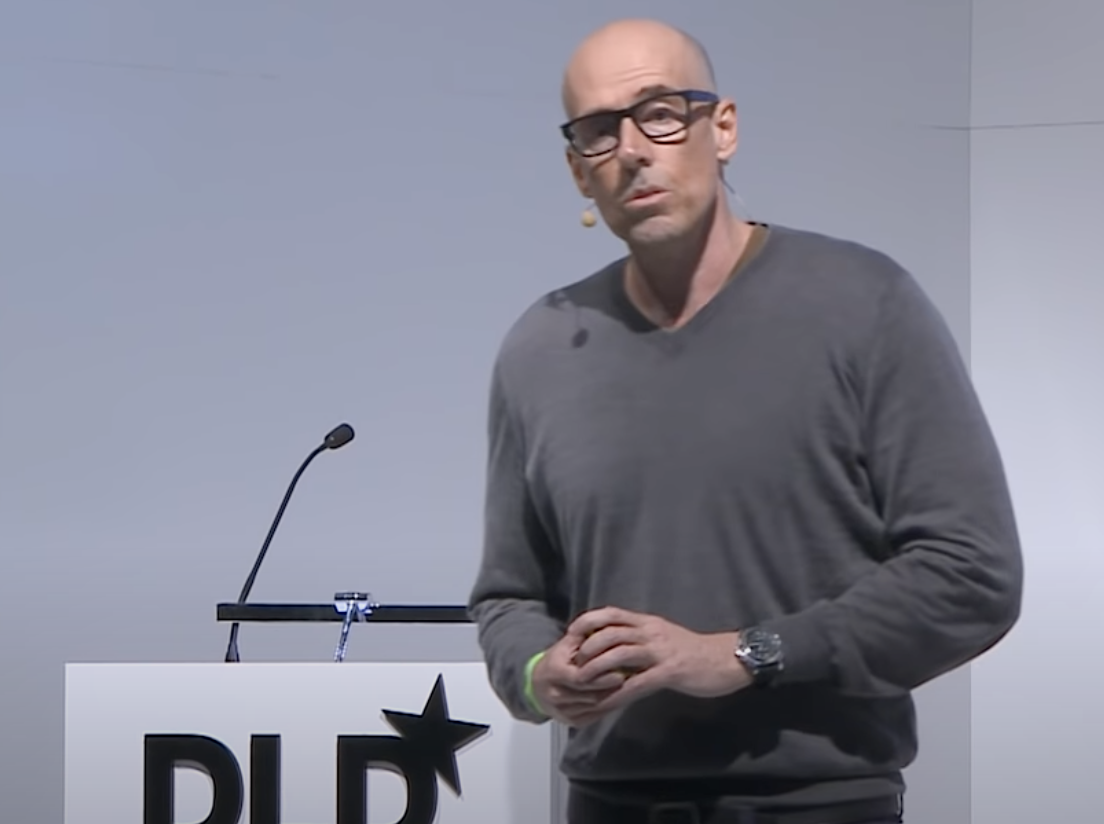 In 2015 I gave a presentation at the DLD Conference about brands and tech. The video of the talk went semi-viral on YouTube after a music industry analyst (@boblefsetz) featured it in his newsletter. Soon after, I had a book deal; I was writing this newsletter every week; CNBC, Fox Business, and Bloomberg were calling me for on-air spots all the time; and the firm I’d founded a few years earlier, L2, began growing 60% a year. I built a studio above my garage to handle the pace of livestreams and TV hits. After working my ass off for 25 years, I was an overnight success. The lesson? Our society, for some reason, links credibility with appearance in a video format endorsed by an umbrella brand (i.e., a broadcast network) or millions of views/likes on a platform.
In 2015 I gave a presentation at the DLD Conference about brands and tech. The video of the talk went semi-viral on YouTube after a music industry analyst (@boblefsetz) featured it in his newsletter. Soon after, I had a book deal; I was writing this newsletter every week; CNBC, Fox Business, and Bloomberg were calling me for on-air spots all the time; and the firm I’d founded a few years earlier, L2, began growing 60% a year. I built a studio above my garage to handle the pace of livestreams and TV hits. After working my ass off for 25 years, I was an overnight success. The lesson? Our society, for some reason, links credibility with appearance in a video format endorsed by an umbrella brand (i.e., a broadcast network) or millions of views/likes on a platform.
When the pandemic hit, Vice TV convinced me we could do an entire show remotely, from that home studio. My wife cried after she saw the first episode. And not good tears. More like “I am deeply disturbed at how bad this is, and what it might mean for our family” kinds of tears. Vice wanted to renew for more episodes … but I said no. The quality wasn’t there, and I realized that my actions need to match my words: I shouldn’t be producing an ad-supported show while I’m publicly criticizing how advertising is media’s carcinogen. That flummoxed them. Being on TV is an addictive substance, and not many people walk away.
Bloomberg, a firm I admire, asked me to do a show for them. With launch just days away, and four episodes in the can, they asked me to do some promotions for social media. In one, I dressed up/down as a “bitcoin miner” (inspired by David Hodo’s construction-worker character from the Village People) and tweeted it out. Twitter liked it, and so did the Bloomberg execs, at first. But the video offended one, or more (still not sure) people in the newsroom, and management asked me to clarify that they hadn’t approved the video (true) and to apologize. I refused as … I wasn’t sorry. The execs were generous with me and wanted to figure out a way forward. However, after meeting with my team, we decided that if we couldn’t do what we do, the juice wasn’t worth the squeeze. So we were canceled (sort of) before the show aired.
Jeff Zucker from CNN offered me a program on its upcoming streaming network (CNN+). I told Jeff what had happened at Bloomberg; he told me he realized his newsroom was not America and said he would protect me. I can see why he fostered such deep loyalty from the people he worked with. So we’ve spent the past few months building our show: No Mercy No Malice with Scott Galloway. So far, CNN+ is a dramatic step change from anything we’ve done previously in terms of depth of talent and resources.
Failing Forward
So, how did this train keep running long enough to carry me to CNN? There are 115 billion reasons. Specifically, that’s how many dollars streaming companies are investing in content this year (plus another $25 billion for sports rights), greater than the defense budget of Germany. This has enabled me, so far, to fail forward. What’s happened here is a decent metaphor for an art form that’s drawn more capital than the combined discretionary budgets for the U.S. departments of Agriculture, Commerce, Justice, Labor, and Transportation.
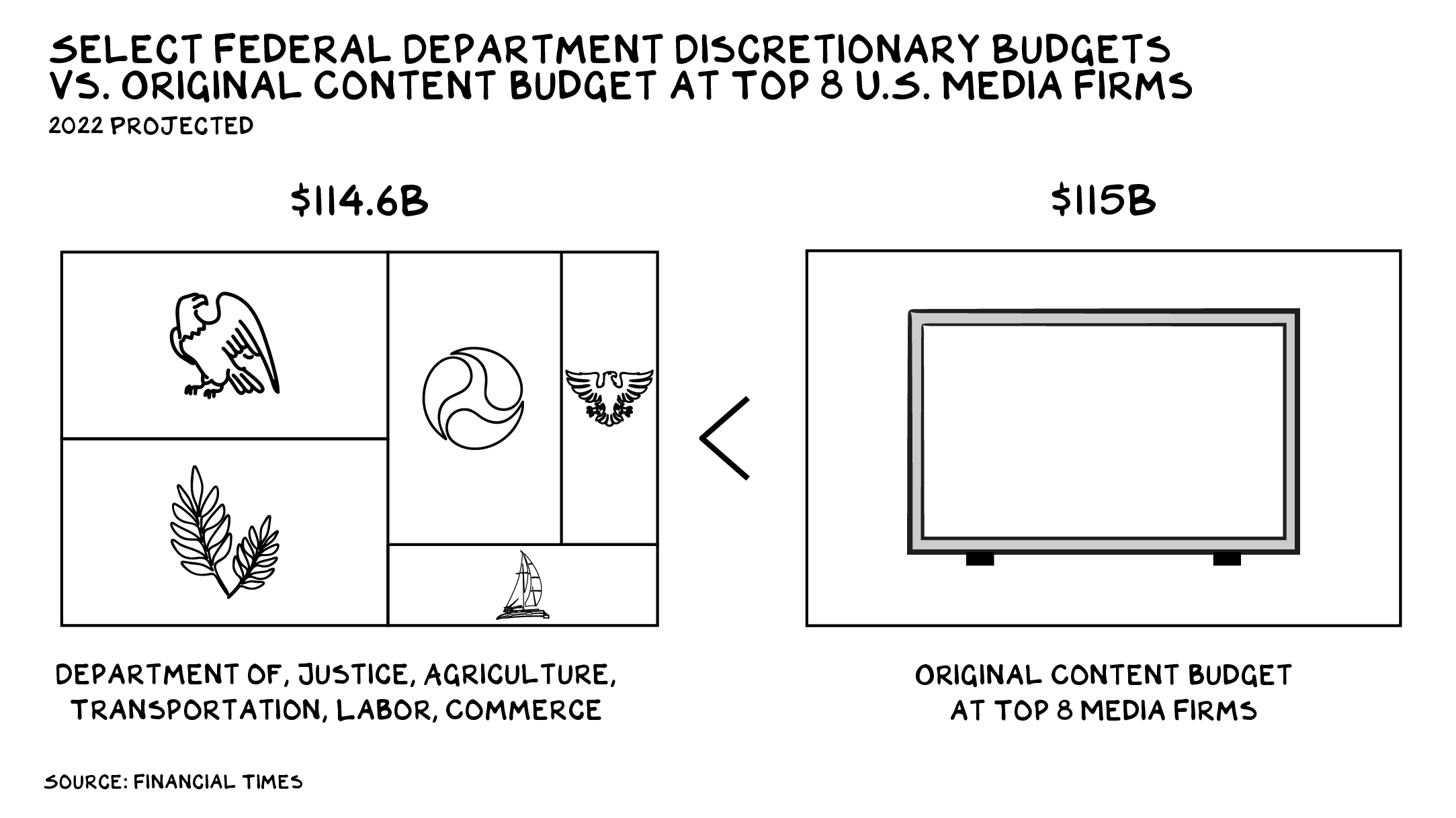
State of Play
In 1998, 55 million people gathered around the TV to watch Titanic win Best Picture. In 2022, 15 million TV viewers watched Coda win. However, on their phones, hundreds of millions saw one millionaire assault another millionaire and then receive an award and a standing ovation. It’s hard to imagine seven seconds that reflect more poorly on America and the age. Maybe January 6, or the former President mocking a disabled person. OK, there’s been several, but that’s not what this post is about. This was the second-least viewed Oscars ceremony ever.
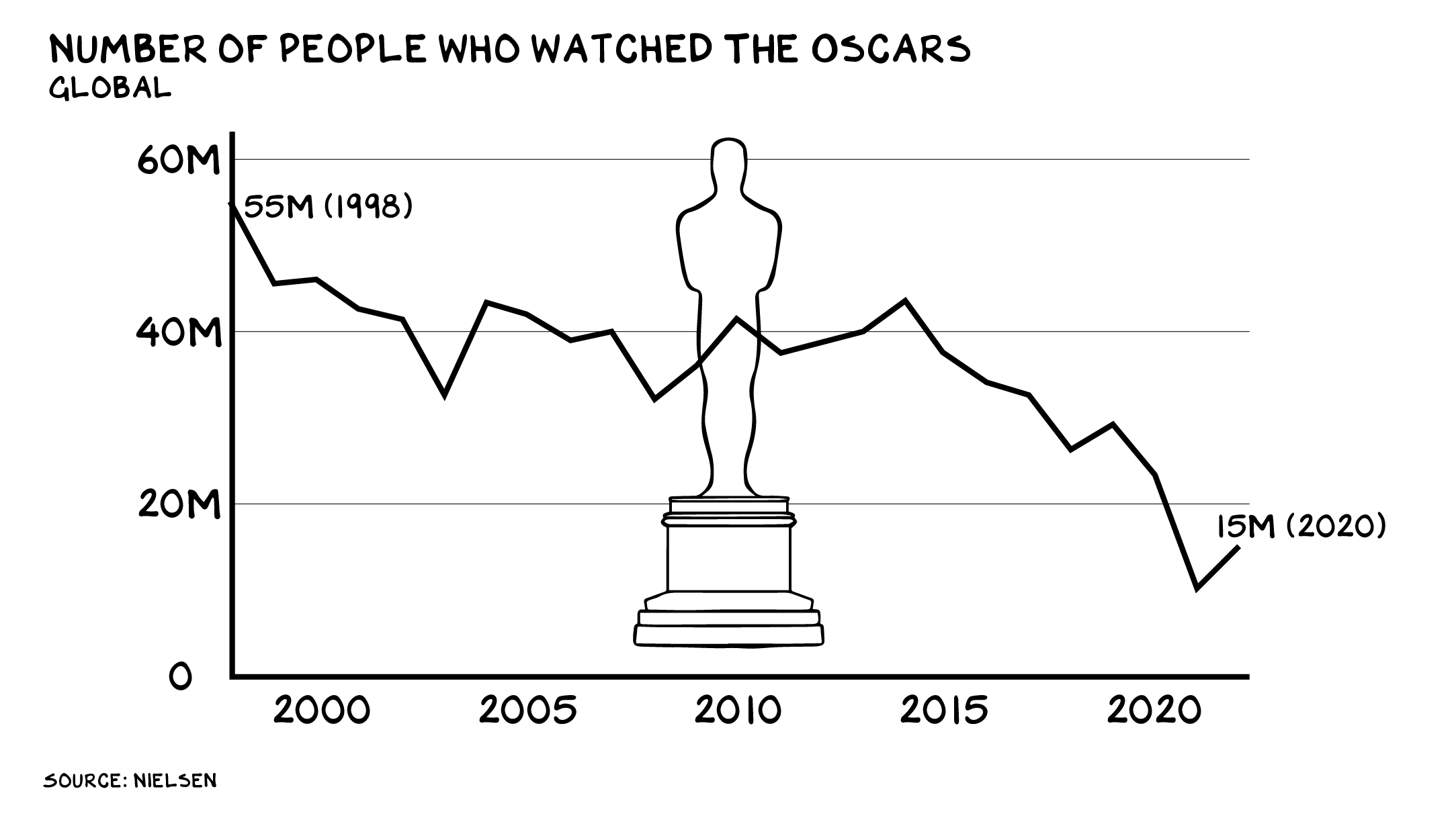
Hollywood used to be the cultural center of the universe. It’s fallen to a close second behind the tech community. The two have a lot in common: Both mix fame and money to create a brazen lack of grace and self-awareness. Perhaps the Academy is the ultimate validation of Netflix’s long-tail strategy: It’s been decades since we saw Best Picture nominees regularly appear in the box office top 10. This year the combined earnings of the 10 nominees were a quarter of the new Spider-Man’s 2021 domestic box office haul of $800 million. Action movies (which are overwhelmingly comic book movies) and adventure movies (aka Star Wars spinoffs) now account for two-thirds of global box office revenue. Many years, the box office top 10 consists entirely of pre-existing IP.
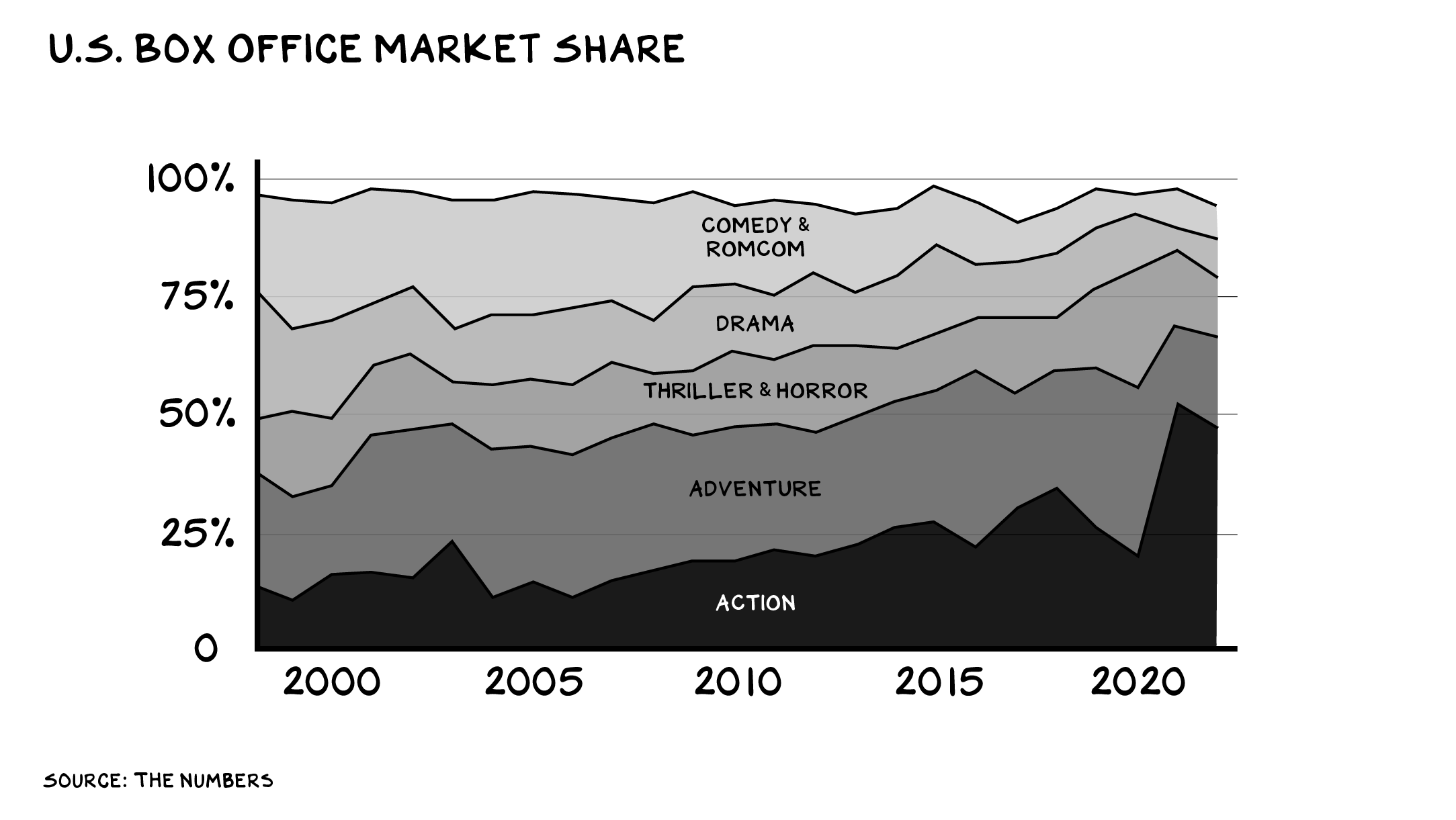
While movie theaters have completed their transformation into genre palaces, billions have gone into “small” screen content for screens that are increasingly bigger. And on the streaming side of the entertainment divide, Big Tech continues to roll. In just the past three years, Netflix has created 1,298 original titles, and it’s received more Oscar nominations than any other studio over that span. The Best Picture award this year went to a company that makes phones, two weeks after Amazon completed an $8.5 billion deal to buy one of the most storied movie studios in Hollywood (home to Bond, Rocky, and Thelma & Louise).
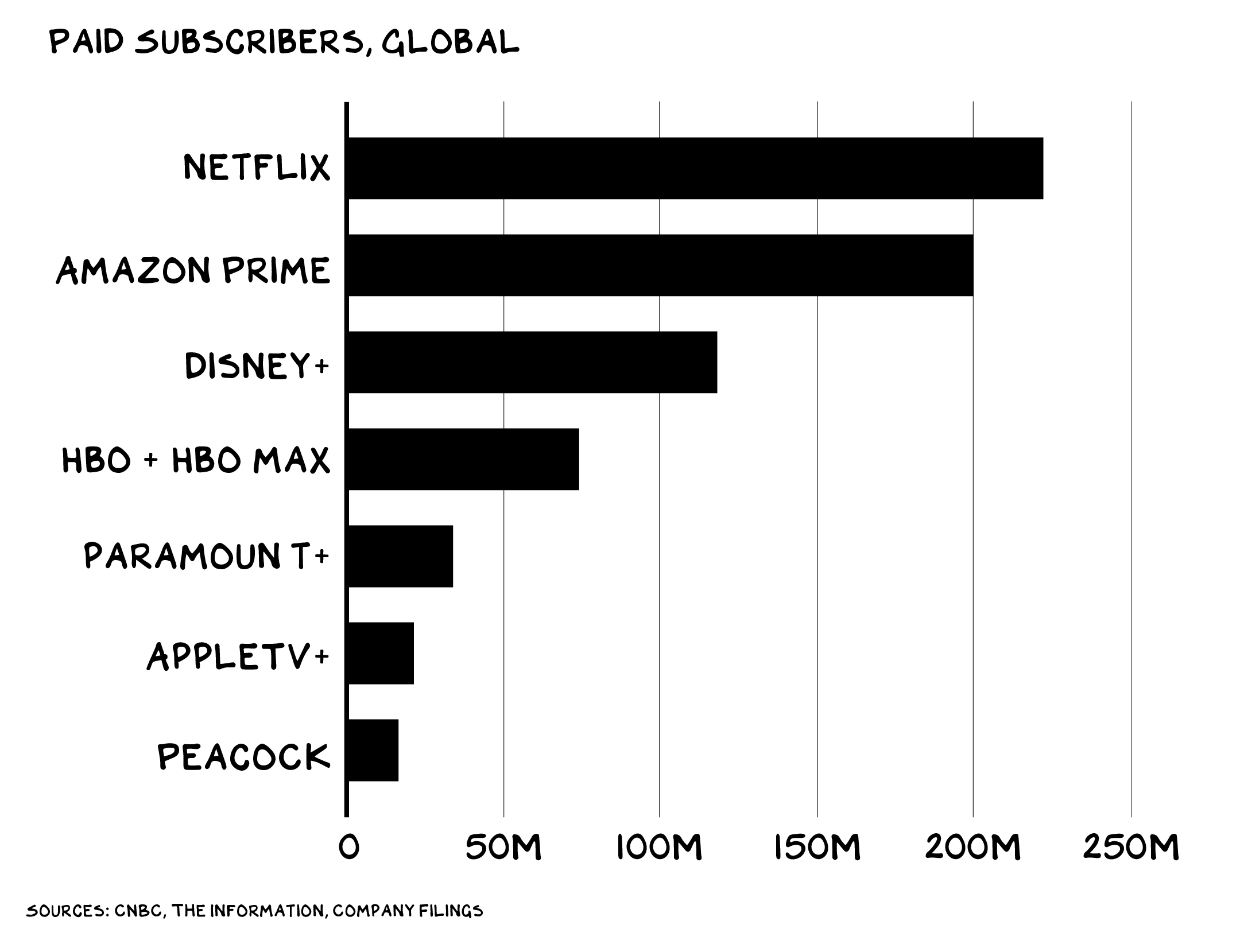
Proceed With Caution
It’s been a phenomenal run for streaming. But as the public and private markets are starting to learn, all runs come to an end. Netflix got a taste of this in January, when it reported its subscriber growth had slowed. The stock dove 22% on the news, setting into motion a larger retreat. Apple and Amazon are immune, because they’re not in the streaming business per se — they use their entertainment offerings as a means of differentiation, vs. an actual business that needs to be profitable. FYI, this is supposed to be one of the reasons we have antitrust laws. But I digress.
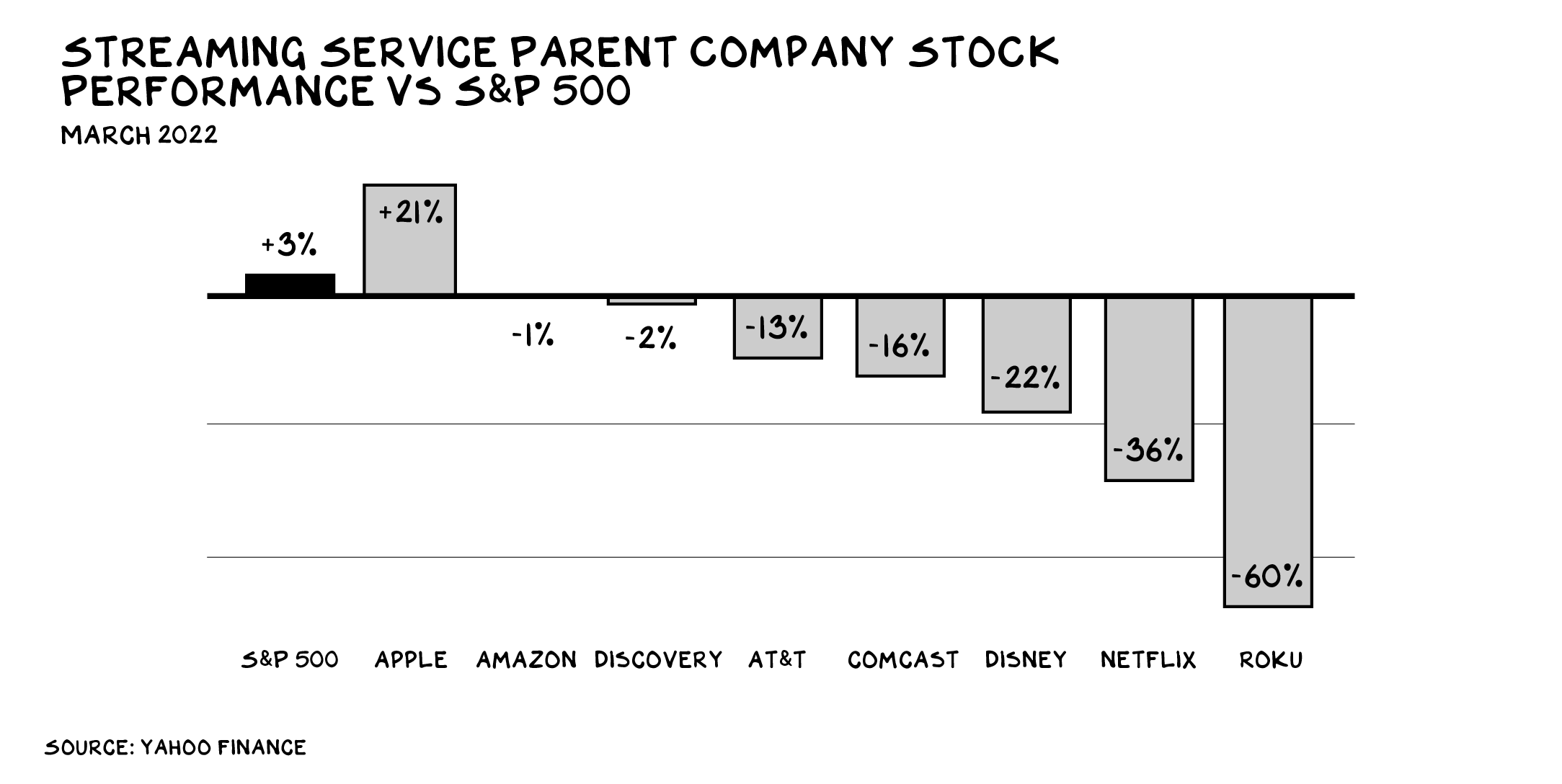
User growth at all costs is great until your user base is too big to grow. The streamers know this, which is why they’re looking for revenue in new places. Specifically: advertising. Disney+ is releasing a lower-priced tier with ads, HBO is experimenting with pre-roll commercials, and Netflix (for whom ads have historically been verboten) has developed a new stance: “Never say never.” And, in a move that has the same risk profile as New Coke, it looks as if Netflix is cracking down on password sharing.
Final Frontier(s)
Two frontiers remain: news and live sports. What trucks are to U.S. auto manufacturers, news and sports are to the cable and broadcast markets. They still account for more than 62% of Americans’ total TV consumption.
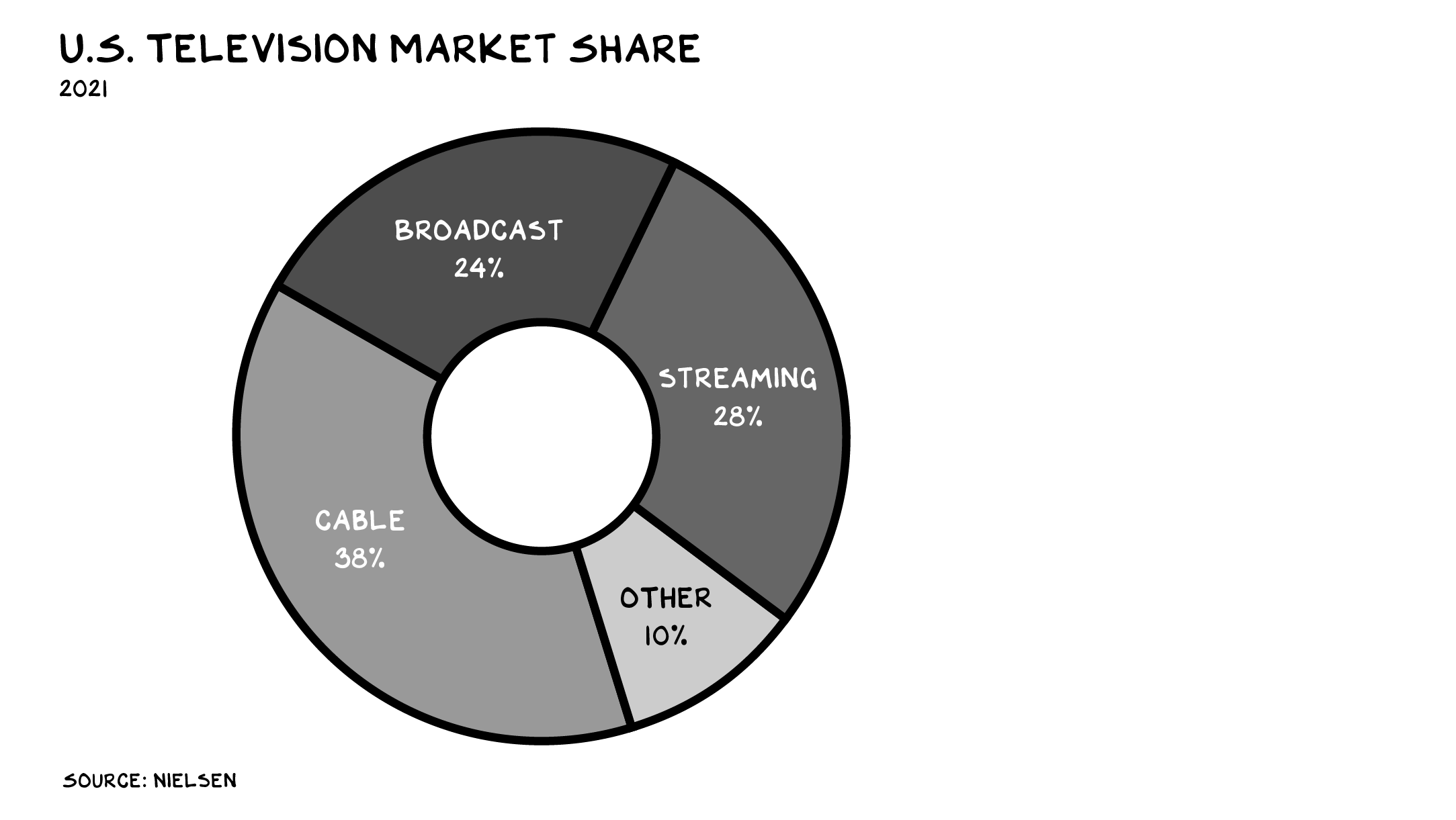
The streamers have been nibbling at sports. Hulu tried leveraging its parent’s access to ESPN, Peacock tried paywalling the Olympics, and Amazon bought its way into Thursday Night Football.
Now CNN+ is asking the important question: Are people down to pay for better TV news? And to be clear, it is better — not as a function of what it offers, but what it doesn’t offer: advertising.
Streamed news is built on a novel proposition: Pay for what you get. U.S. news broadcasting has long been subsidized — neither we nor the ads we watch cover the costs. In the era of the Big Three, the nightly broadcasts that defined “TV news” for generations of Americans were money losers, but the networks invested the profits of prime-time sitcoms and daytime soaps into them to burnish their brands. “I have Jack Benny to make money,” the head of CBS told his news division.
Since 1967 the federal government has funded PBS and other stations, with a mission to deliver unbiased journalism throughout the nation. Cable news stations enjoyed subsidy by bundle: Sure, you really wanted ESPN and the Comedy Channel, but you were going to pay for Fox News and MSNBC, like it or not. Today news is bundled with data-harvesting — 86% of Americans consume news on a digital device, with 1 in 3 getting it from Facebook and 1 in 5 getting it from YouTube. In sum, we don’t have much experience paying for the most important content we consume.
It’s possible, however, that America is done with misinformation posing as news on social platforms — and this could be the wind in CNN+’s sails. Yes, you can still find CNN content on Facebook, but your diet there is determined by the algorithm, which wants to enrage vs. inform you. The streaming option (CNN+) feeds our digital habit with a diet shaped by an editorial board of journalists. The cable news players are also guilty of relying on novelty and opinion to keep you around until the next ad for an opioid-induced constipation medication.
The move from news to novelty, networks attacking each other, and the assigning of news brands to identity and politics has been accompanied by an enormous erosion in trust.
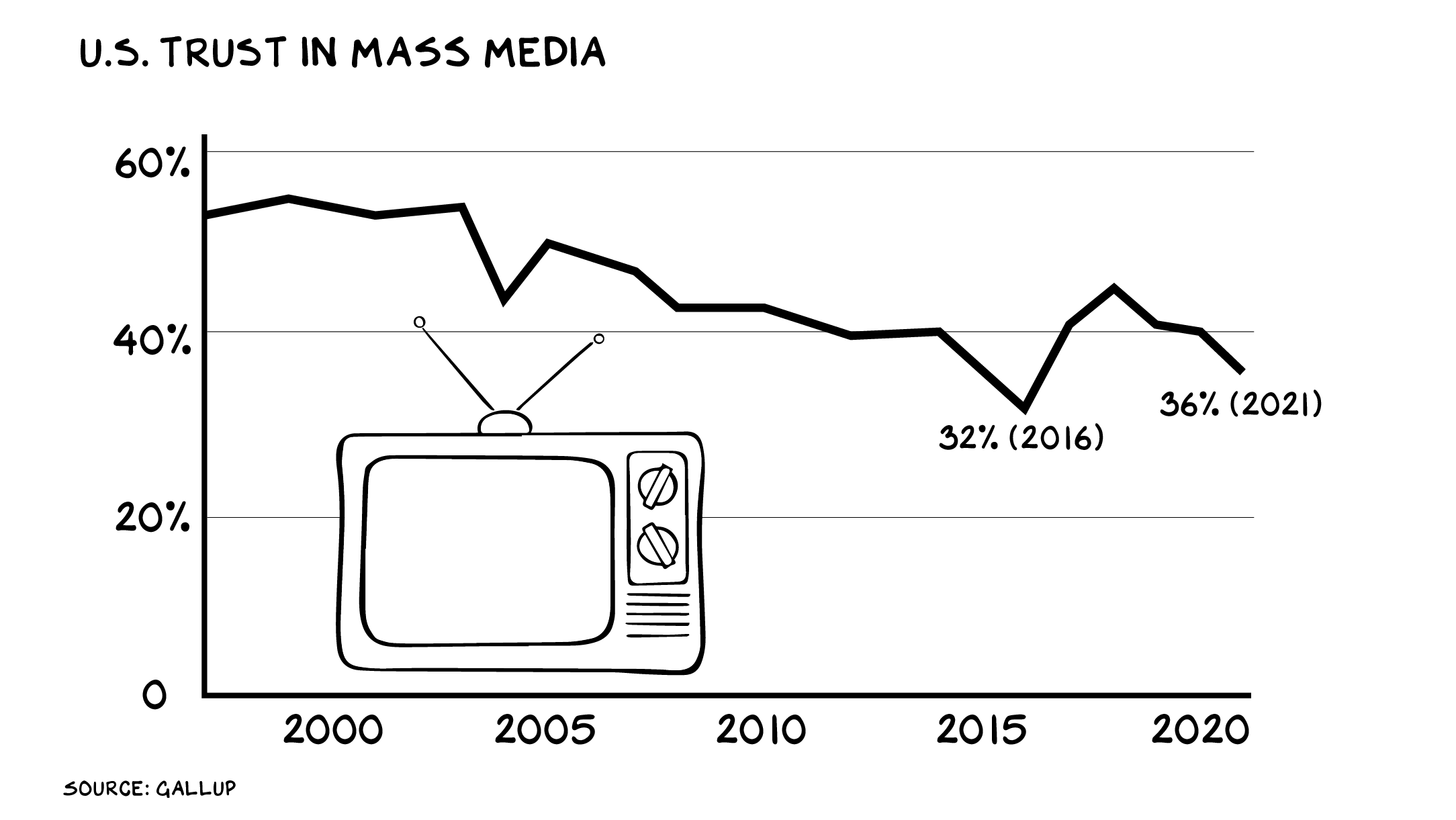
Putting cable in our pocket also means untethering networks from cable’s soft tissue. Specifically, the clock and the need to communicate a certain amount of news regardless of how much news there is that day. Streaming fixes this. Slow business day? Five-minute segment. Superpower invades sovereign nation? Three-hour special. This might also disincentivize the network from creating extraordinary headlines about unextraordinary events. We can discuss this tomorrow in The Situation Room. I hear Fox’s streaming platform is being rebranded The Panic Room.
One thing that could hold CNN+ back is it hasn’t gone all-in, and it likely never will. Cable news is trapped in a classic Innovator’s Dilemma. Which is why Anderson Cooper is still on the network (in addition to CNN+): Putting AC completely behind a paywall risks the serious cabbage that reverse mortgage brokers and statin manufacturers pay to interrupt him. Media successes tend to be pure-play, all-in affairs: In the cable era, ESPN, CNN, and HBO were new ventures. Netflix is the king of streaming scripted content; Facebook, Instagram, Snap, and Twitter rule social. Not a brand extension in the lot.
I suspect we’re going to get a read on CNN+ crisply. CNN is part of WarnerMedia, which AT&T is in the process of selling to Discovery (the complex deal closes Tuesday, April 5). Warner is the much larger entity, however, so AT&T shareholders will end up with 71% of the resulting Warner Bros. Discovery. And that AT&T legacy shareholder base didn’t buy AT&T stock to own the cash flow from Jake Tapper’s Book Club. (OK, that’s a bit passive aggressive — his show is trending above mine according to the app. Anyway … ) You own AT&T for predictable results and reliable dividends.
But to compete in streaming, Warner Bros. Discovery is going to have to make big bets. Expect a lot of legacy shareholders to bail, putting downward pressure on the stock. WBD will also inherit a sizable debt load from AT&T, which could inhibit the company’s flexibility around investment. All of which adds up to one thing: Management needs quick wins. Signs of traction could result in a streaming-like multiple; anemic results could make it an easy cost-cutting target for a new owner or activist. Few explorers don’t encounter rough seas or bears. But CNN+ has big sails and decent wind. Beneath the tribal noise we make about our preferred cable brands, the world still turns to CNN in a crisis. Viewership jumped by a third after Russian tanks rolled into Ukraine. Ted Turner’s company has never stopped investing in the muscle fibers needed to command that space: Four thousand employees work in 39 editorial operations around the world. Plus AC, Doc G, C Pour, C Dub, the Wolf, and the sexiest bald guy in America — Stanley Tucci.
Short and Windy Road
My adventures in television have, so far, been short … and violent.

As I sit here writing this, my dogs are lying on my lap and my kids are asleep in their beds. One question, present and clear, runs through my head: Why am I doing this? I don’t need the money, and the show will be a small part of my professional endeavors … that will take a lot of time. I tell people I want to be the most influential thought leader in the history of business and create economic security for the people I work with … and that involves being multi-channel. It’s mostly bullshit. I probably have more impact through books and teaching, and can make much more money on boards, speaking gigs, investing, etc. Also, I’m not sure I’ll ever be great at this: I have a face for podcasting, and I share CNN+’s vulnerability — I’m not all-in here. TV is just something I do … it’s not what I do.
So, why? I think it comes down to death. Specifically, my atheism. I believe this (i.e., our time on Earth) is not a dress rehearsal. This. Is. It. And time is just going so fast. Research shows end-of-life regrets aren’t about the mistakes you made, but the risks you didn’t take. The fears that got in the way of going for it. I have a chance to be on CNN, do something new, and be a part of the art form that defines our age (I believe this). Also, my kids seem impressed, which is nice…and rare. In sum, I don’t know if this will work, if I will enjoy it, or if I’m any good at it. But I’m here, in the moment, living life, trying to avoid regret, and ready for my close-up.
Life is so rich,

P.S. Maybe you’ll be the one to lead the next innovation in media. It couldn’t hurt to take our Platform Strategy Sprint, enrolling now.



